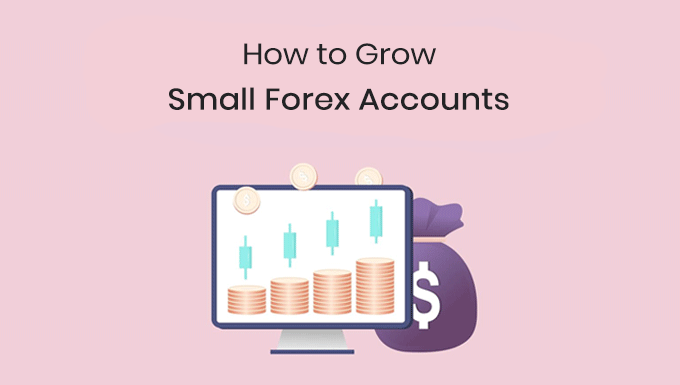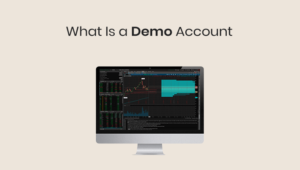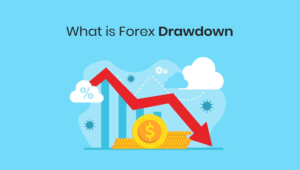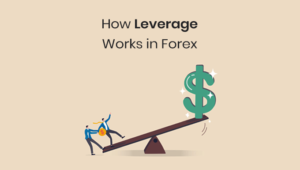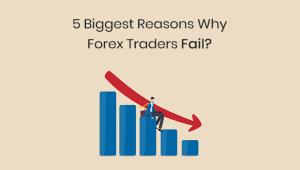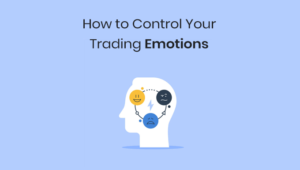Hey, traders! You’ve probably heard the saying, “To make money, you need money.” But when it comes to Forex trading, this isn’t always the case. Starting with a small account? No problem! The focus of this article is to explain 10 Tips to grow small Forex accounts fast. So, if you’ve got limited capital but looking for ways how to grow a small forex account, you’re in the right place.
Why Start Small in Forex?
Less Risk
Trading with a small account minimizes financial risk and makes losses more affordable. Smaller stakes also reduce the stress associated with the fear of losing large money, enabling better decision-making.
Easier Emotional Management
Trading successfully with a small account can build your confidence, making you more prepared when you decide to invest more substantial amounts. The lower stakes also mitigate the fear factor, making it easier to stick to your trading plan.
Better Money Management
It’s generally easier to adhere to disciplined money and risk management practices when dealing with a small account. For instance, you can more readily follow the rule of not risking more than a small percentage of your account on a single trade.
Learning Curve
A small account size provides a less risky environment to navigate the steep learning curve associated with Forex trading. This allows you to make mistakes, learn from them, and improve without making huge financial losses. It also helps you to develop trading discipline, which is crucial for long-term success in trading.
Cost Efficiency
Trading with a small account often means fewer transactions, which can lead to lower commissions and fees. Additionally, you can better understand the impact of leverage on your trades without the risk of catastrophic losses.
Strategy Testing
Starting small offers the flexibility to experiment with different trading strategies and to adapt your approach based on the outcomes, all without the fear of losing significant capital.
Understanding Trading Capital
What is Trading Capital?
Trading capital is the amount of money you allocate specifically for buying and selling financial instruments like stocks, forex, or commodities. It’s your “play money” in the game of trading—a game where losing is just as possible as winning.
Don’t Risk Essential Money
Let me spell it out for you: Never, ever risk money you can’t afford to lose. We’re talking about essentials like rent, groceries, and other life necessities. If losing your trading capital will ruin your financial stability, then it’s too much.
The Psychology of Small Accounts
Small accounts often induce a feeling of urgency. You want to grow it fast, so you start taking risks, maybe too many. But here’s the thing: You need to balance that sense of urgency with calculated decisions. A small account isn’t a ticket to gamble—it’s an opportunity to grow.
Setting Realistic Goals
Timeframe for Growth
Are you planning on doubling your account in a week? Hold on, cowboy! While setting goals is great, they need to be realistic. Set achievable milestones based on your skill level, trading strategy, and market conditions.
Expected Rate of Return
It’s tempting to aim for sky-high returns, but a more reasonable rate will keep you grounded. Start small, get some wins under your belt, and then reassess.
Speed vs. Risk
Remember, the faster you want to grow, the higher the risks involved. There’s always a trade-off. Do you want to be the hare who burns out or the tortoise who wins the race? Your choice.
Importance of a Trading Plan
No successful trader just “wings it.” You need a roadmap—a trading plan.
Key Components
Your plan should include your risk tolerance, profit goals, evaluation criteria, and, most importantly, your trading strategy. Nail these down before you even think about opening a trade.
Why a Plan is Crucial
A trading plan keeps you disciplined. It’s like a personal trainer in the gym, pushing you to stick to your regimen, helping you to avoid impulsive decisions that can cripple your account.
10 Strategies to Grow a Small Forex Account Fast
Growing a small forex account needs a careful balance between risk and reward. Here are 10 strategies that can help you grow a small forex account into a substantial trading account:
1. Leverage: The Power and The Pitfall
Understanding and managing leverage is crucial in Forex trading. While leverage can dramatically amplify your profits, it can also just as quickly lead to significant losses. It’s important to use leverage wisely, making sure you know the risks and not carelessly maxing out your leverage limits.
Tips:
- Limit Leverage: Using too much leverage can decimate a small account quickly. Use leverage conservatively.
- Risk Management: Implement stop-loss orders and other risk management tools to protect against large losses.
2. Master the Art of Scalping
Scalping is a fast-paced trading strategy that aims to capitalize on small price changes in the market. It involves making a large number of small trades within seconds or minutes. The key is to be disciplined and to understand market conditions that favor this approach, as even small losses can quickly accumulate.
Tips:
- Precision: This strategy requires a well-thought-out entry and exit strategy.
- Low Costs: Choose brokers with low spreads and commissions as transaction costs can quickly eat into your profits.
3. Embrace Swing Trading
If you’ve got a bit more patience, swing trading can be an excellent strategy. It is an excellent option for those who can afford to keep their positions open over several days or even weeks. The strategy seeks to capture gains from short-term price movements and is particularly effective when you can identify the beginning or end of an upcoming market trend.
Tips:
- Technical Analysis: Use technical indicators like moving averages and trend lines to identify potential swings.
- Patience: This strategy demands the patience to let trades develop over a more extended period.
4. Day Trading for Quick Turnaround
Day trading involves opening and closing trades within the same day. It is best suited for traders who can dedicate time to monitoring the markets closely and making quick decisions. While day trading can be lucrative, it also requires a good understanding of technical indicators and a well-thought-out strategy.
Tips:
- Quick Decisions: You’ll need to make quick, well-informed decisions.
- Discipline: Stick to your trading plan and don’t let emotions cloud your judgment.
5. Use a Tight Stop Loss
Implementing a tight stop-loss can help you minimize losses, especially when you’re starting. It allows you to automatically exit a trade if the market moves unfavorably, thereby minimizing your losses. However, setting your stop loss too tightly can mean that you’re taken out of the trade by minor market fluctuations, so balance is crucial.
Tips:
- Balance: Set your stop-loss neither too tight nor too loose to strike a balance between minimizing loss and not getting prematurely stopped out.
6. Try the Martingale Strategy
The Martingale strategy can be risky but also rewarding. It involves doubling your trade size after each loss in the hope that an eventual win will recover your previous losses and add some profit. While this strategy can work, it’s risky because it can quickly deplete a small account if the market goes through a prolonged downturn.
Tips:
- Risk: This is a risky strategy—only use it if you have a deep understanding of its mathematical and emotional implications.
7. Follow the Trend
“Trend is your friend” is a golden rule in trading. Being able to identify and trade in the direction of the market trend can reduce your risk and increase your chances of making a profit. However, it’s also crucial to know when a trend is likely to end and adjust your strategy accordingly.
Tips:
- Indicators: Use trend indicators like moving averages to identify the prevailing trend.
- Confirmation: Look for confirmatory signs before making a trade.
8. Risk-Reward Ratio
One of the most effective ways to manage risk is by using a risk to reward ratio for each trade, ideally something like 1:2 or even 1:3. This means that your potential profits should always be at least twice as large as your potential losses, allowing you some cushion for error.
Tips:
- Target Ratio: Aim for a minimum risk-reward ratio of 1:2.
- Adjust Strategy: Reevaluate your trading strategy if you’re not meeting your desired risk-reward ratios.
9. Diversify Your Portfolio
Don’t put all your eggs in one basket. Diversification can be a bit of a double-edged sword. While diversifying your positions across different currency pairs can protect you from adverse market conditions, it also requires more time and effort to manage multiple trades.
Tips:
- Balance: Diversify but don’t dilute. You don’t want to spread your capital too thin.
- Correlated Assets: Be cautious of inadvertently increasing your risk by choosing correlated assets.
10. Keep Learning
The Forex market is constantly evolving, and staying educated is crucial for success. Make it a habit to read news, follow market analyses, and learn from other traders, as well as from your own experiences. Continual learning will help you adapt to changing market conditions and refine your trading strategies.
Tips:
- Stay Updated: Follow market news, trends, and updates from trustworthy sources.
- Continuous Learning: Take advantage of best forex courses, tutorials, and forums to keep improving your trading skills.
- Learning from Mistakes: Mistakes are learning opportunities in disguise. Use them to refine your strategy and move forward.
By implementing these 10 strategies, you can optimize your chances of rapidly growing your small Forex account.
Tools to Use to Grow a Small Forex Account Fast
To succeed in growing a small forex account, leveraging a variety of tools and platforms is essential. These resources provide invaluable insights, automation, and risk management options that can be instrumental in executing profitable trades. Here are 7 useful tools:
1. Trading Platform: MetaTrader 4 or 5
MetaTrader 4 and MetaTrader 5 are comprehensive trading platforms that provide a wide range of features for forex trading, from advanced charting tools to customizable indicators. Known for their user-friendly interface, these platforms allow you to perform in-depth technical analysis, add custom indicators and scripts, and even employ automated trading strategies.
2. Economic Calendar
An economic calendar is essential for tracking major financial events that could impact currency pairs, such as central bank decisions or employment data. Utilizing an economic calendar can help you capitalize on market movements and manage risks by avoiding high-volatility periods.
3. Forex Signals
Forex signals offer trading recommendations for specific currency pairs and timeframes. These signals can serve as a useful source for trade ideas, particularly for those who can’t keep a constant eye on the markets. However, traders should exercise caution, as signals can sometimes be incorrect; your own analysis should always be the final arbiter.
4. Risk Management Tools
Risk management tools like stop-loss and take-profit orders are invaluable for any trader. Stop-loss orders can save you from severe losses by automatically closing trades at predetermined levels, while take-profit orders can lock in gains by exiting trades once a certain profit level has been reached.
5. Technical Analysis Software
Specialized software programs are available for performing technical analysis on market data, such as TradingVew. These programs facilitate an in-depth study of price action, indicators, and can often automatically recognize specific chart patterns, offering another layer of insight for traders.
6. Expert Advisors (EAs)
Expert Advisors are automated trading bots capable of executing trades based on specific, predefined criteria. These bots allow for 24/7 trading and are particularly useful for maintaining a consistent trading strategy, without the influence of emotions. However, like any tool, they come with risks, including the potential for mistakes and significant losses during rapid market changes.
7. Demo Accounts
Demo accounts offer a risk-free environment for practicing trading strategies. Funded with virtual money, they allow you to get accustomed to trading platforms and tools without the danger of financial loss.
By making optimal use of these tools, traders with smaller accounts can refine their skills, manage risks more effectively, and accelerate the growth of their accounts.
Conclusion
Growing a small Forex account fast is not a walk in the park, but it’s definitely doable. Start by picking the right trading strategy that aligns with your skills, risk tolerance, and market understanding. Utilize tools and resources available to make informed decisions. Above all, continue learning and adapting because the Forex market is ever-changing.
FAQs
Q: How much money do I need to start Forex trading?
A: The minimum amount varies among brokers, but you can start with as little as $50 to $100.
Q: Is leverage a good idea for a small account?
A: Leverage can amplify gains but also increase risks. It’s advisable to use it cautiously, especially when you’re just starting.
Q: Can I become a millionaire with a small Forex account?
A: While it’s possible, becoming a millionaire from a small account would require extremely high risks, which may not be sustainable in the long term.
Q: How much should I risk per trade?
A: A general rule is to not risk more than 1-2% of your account on a single trade. This allows you to withstand multiple losses without severely damaging your account.
Q: Is automated trading a good option for growing a small account?
A: Automated trading can be a useful tool, but it’s essential to backtest your strategy extensively before letting a machine handle your trades.
